Powis Castle: An exemplary, inspirational and uplifting garden full fit for the 21st century
Non Morris visits Powis Castle in Welshpool, a plantsman’s paradise that reveals more and more as you traverse its many terraced layers. Photographs by Val Corbett.

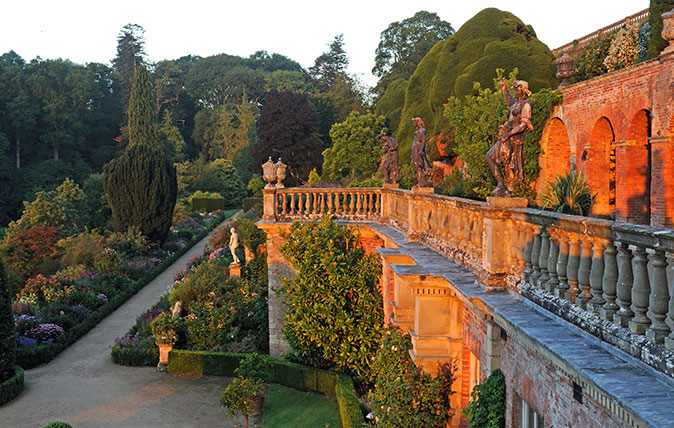
If you happen to have a picture of Powis Castle in your mind, it’s likely to be one of a tall, properly castellated stronghold, looming high at the top of a multi-tiered Powys hillside lined with a storybook row of bulging yew shapes. What’s so exciting about visiting its gardens is that they’re more extraordinary and uplifting in the flesh than even the most beguiling photograph might suggest.

There’s a heightened sense of anticipation that comes with the revelation of each terraced layer of the garden one after the other, an almost surreal intensity of colour and perfection in the border planting and hedges of an improbable scale and drama that screen and then reveal the next delightful scene.
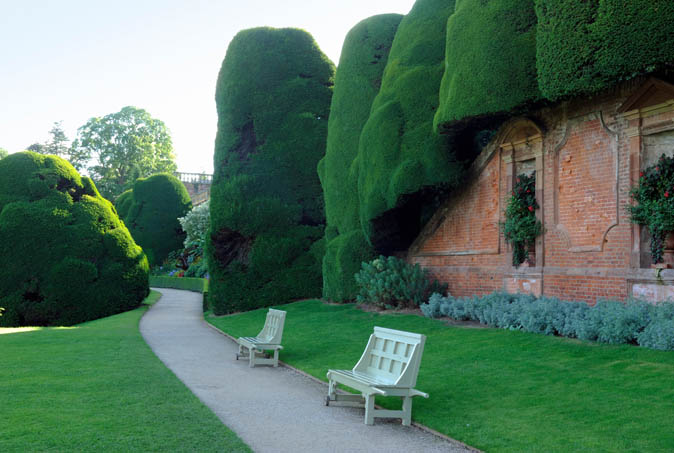
In the case of the serpentine Box Walk, which links the lower formal garden to the upper levels, you feel as if you’re travelling along a powerfully scented, deep-green luge track and, when you arrive at the heady exotic planting of the Top Terrace, the contrast with the benign Welsh farmland stretching out below only makes you scratch your head and smile, happy to be lost for an hour or two drinking it all in.

The garden we see laid out before the medieval castle today was carved out of steeply sloping ground on its south-east side in the late 17th century. William Herbert, 1st Marquess of Powis, gave architect William Winde—creator of the gardens at Cliveden—the task of creating a series of terraces out of the craggy hillside. Once the rock was blasted out, substantial retaining walls and huge amounts of topsoil were needed to create the Top Terrace, the Aviary Terrace and the Orangery Terrace.
These, planted with neat topiary shapes and trained fruit trees and edged in yard upon yard of fine stone balustrading, lead via flights of steps down to the Lower Terrace, the grassy Western Bank and, finally, to the spreading Great Lawn.
An elegant and spectacular space for outdoor entertainment was thus created, which had the added bonus of being completely hidden from view until the visitor arrived at the castle and emerged onto the upper terrace.

The 1st Marquess, a Catholic, fled to France in 1688 before the gardens were completed and, as time and fashions went by, so the garden underwent a series of adaptations. The 2nd Marquess added a water garden in the Dutch style on the flat land beyond the terraces—with pools, shaped grass plats and a grand cascade—and, in 1771, in a bid to keep in with the Picturesque mood of the time, the 1st Earl of Powis diverted the public road where it passed close to the north side of the castle and planted a swathe of woodland on the ridge to the south. This became known as the Wilderness and many of its fine oak trees still provide important shelter and privacy.
Exquisite houses, the beauty of Nature, and how to get the most from your life, straight to your inbox.
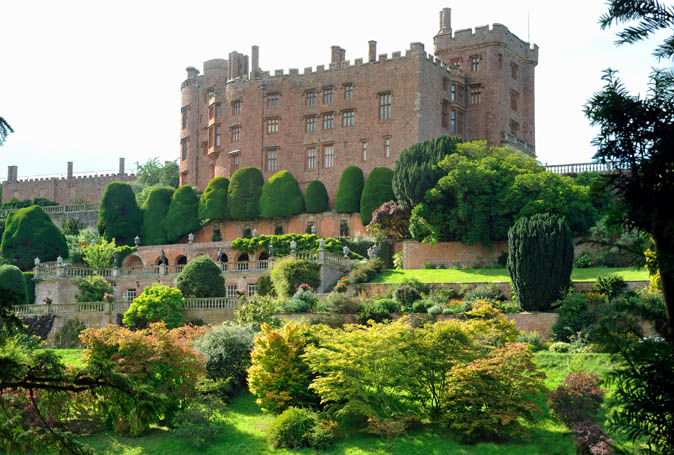
When the 2nd Earl abandoned Powis in 1784 for the bright lights of London, the elaborately clipped yews on the upper terraces were left to grow into trees and, in the 19th century, the Dutch water garden was replaced by a simple lawn with grazing deer. In the early 20th century, Violet, wife of the 4th Earl, set about re-energising the garden. She had the kitchen garden and glasshouses hidden away behind the Wilderness and developed the resultant well-cultivated spaces into comfortable Edwardian-style garden rooms.
During this time, the remaining yews were shaped again, emerging as a handsome sculptural framework for the garden’s newly enriched and colourful planting.

Violet’s Croquet Lawn is home to one of the loveliest borders at Powis: it’s spectacular, with delphiniums and yellow lupins in early summer and 12ft-high hollyhocks later in the season. I ask head gardener David Swanton for the secret of his rocketing, rust-free hollyhocks.
The answer is serious staking—he takes me to see a covetable store of sturdy pea sticks and hazel wands that are the backbone of the immaculate borders here—and a regime of removing all the leaves when the plants are 1ft high, leaving clean plants, which are then sprayed as a belt-and-braces move.
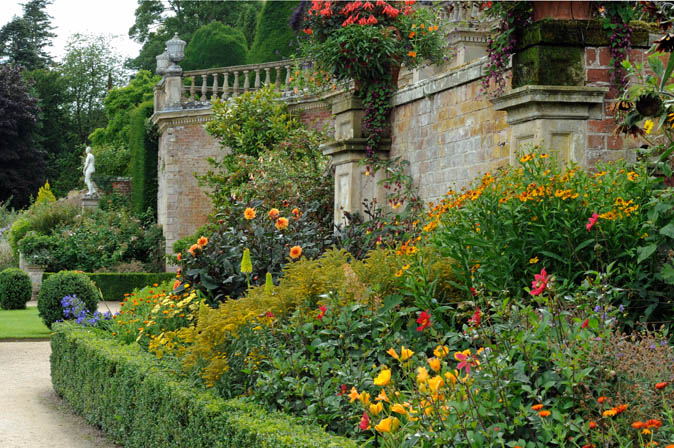
In the formal garden, two fine avenues of 100-year-old apple trees, clipped into acorn shapes, divide up the space. They’re underplanted with smart circles of felty-grey Stachys byzantina, golden marjoram (the flowers removed to keep it as a pool of
yellow) and silvery lamium. Mr Swanton explains that, because the trees are so fragile, his team picks the apples and puts them out for visitors to help themselves. This is typical of the thoughtful, personal way in which Powis is gardened, despite its seeming grandeur.
The view up to the castle from here is cleverly balanced by the choice of shrubs that act as an informal skirt at the lowest level. A soft band of acer and cotinus turns red and purple in autumn, echoing the rosy stone and brick above.
We arrive at the Orangery Terrace, perhaps the most elegant tier. The sash-windowed central Orangery is cool and chalky-white within, its entrance gorgeously framed by the pink-flushed gold of Rosa Gloire de Dijon. A row of Seville orange trees in terracotta pots and a tremendous pair of clipped holly domes create a sense of order from which a pair of 150ft double borders stretches out on either side.
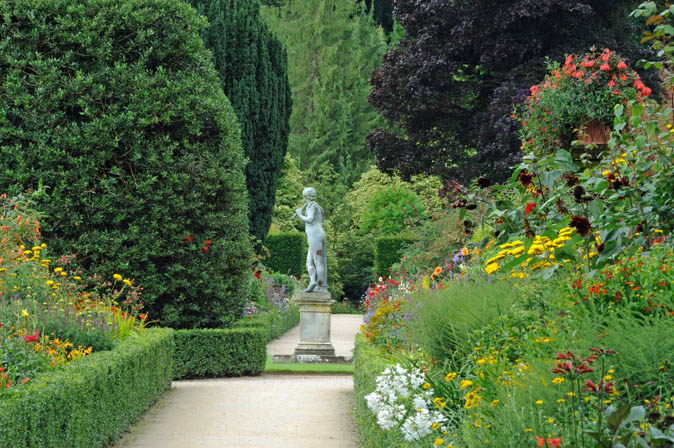
To the east, the colours are cool: soft mauves, pinks and blues. There is the perfectly named Geranium Blue Cloud, delicate spires of Veronicastrum virginicum Pink Glow and the graceful single pink rose Sweginzowii.
The temperature rises in the western borders, which are full of richly coloured crocosmia, helenium and the floating mustard-yellow heads of achillea, energised further by towering rusty-coloured sunflowers and Centaurea macrocephala, a big fat yellow thistle that makes you grin.

Next up is the Aviary Terrace, its balustrades cheerily populated with lead figurines. The Aviary provides a lush and atmospheric place in which to sit behind arches heavily draped in lime-green Japanese wisteria. The creeping fig, Ficus pumila, forms a delicate green trellis on the barrel-vaulted ceiling and muscly sheaves of arched chain fern leaves spring out from raised beds against the walls.
Finally, to the Top Terrace. To the west, the staggering, cloud-like 45ft yew hedge juts out from the castle wall and into the sky. This hedge is the source of many stories: an electrifying Herbert family picnic on its flattish top, the shapes people see in its undulating bulges (Homer Simpson is popular) and the photograph of gardener Dan Bull trimming the hedge from a cherry picker that had a quarter of a million hits on Facebook.

To the east, there’s the billowing exotic border, with huge-leaved bananas, space-age Osteospermum Whirligig and black-purple Aeonium Zwartkop lurking among jewel-coloured zinnias.
A visitor approaches to thank Mr Swanton for the uplifting planting. He could not be more charming in reply and confesses to me afterwards that one of the most extraordinary things about his job is how much praise the gardening team receives.

At the centre of the Top Terrace, under the fairytale mushrooms of yew and above a low hedge of Artemisia Powis Castle (a plant spotted by a previous head gardener and grown for its silvery foliage), there’s a row of five terracotta urns in Baroque niches brimming over with the heavy crimson flowers of Fuchsia Gartenmeister Bonstedt, richly coloured salvias and the trailing dark-purple bells of Rhodochiton atrosanguineus. There is something both delightfully old-fashioned and yet vibrant and up to the minute about this voluptuous combination. The generous use of planted containers has been a Powis tradition since the early 18th century.
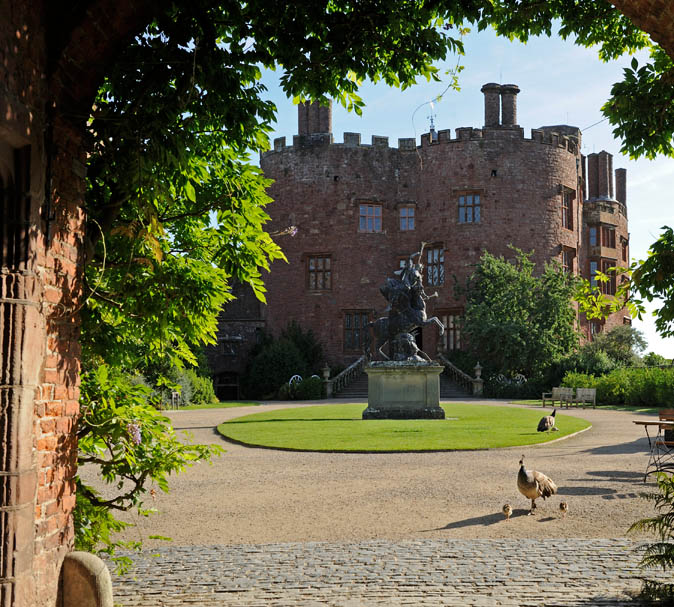
Detailed plant lists are available and many of the difficult-to-source plants are for sale in the nursery. Another extraordinary Powis fact is that, with two out of seven full-time gardeners working away in the glasshouses, if ever there’s a special request for a plant not currently available in the nursery, the team will ‘see what they can do’ to propagate one specially.
I leave dreaming of my new favourite combination: the salmon fuchsia Kolding Perle with the claret clover-like leaves of Oxalis vulcanicola. Powis Castle is an exemplary and inspirational historic garden, gardened with heart and fully fit for the 21st century.
Powis Castle in Welshpool, Powys, is open to the public – see www.nationaltrust.org.uk/powis-castle-and-garden

The walled garden at Glenarm Castle, full of surprising, exhilarating and fiery colours
Glenarm Castle's walled garden is a testament to the endless nurturing enthusiasm and creativity of those who care for it,
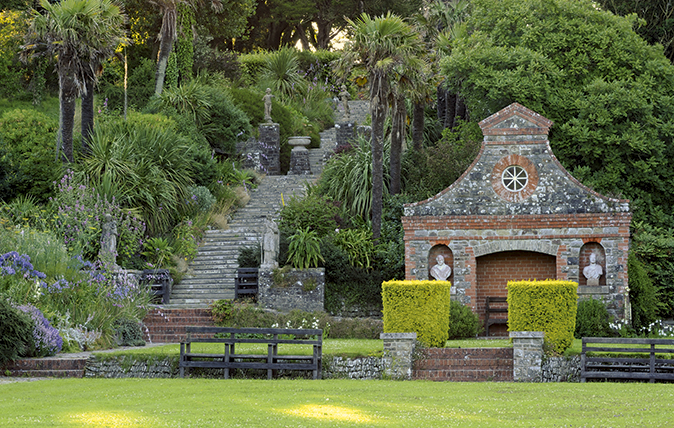
Tapeley Park: A Devonshire garden filled with dramatic flourishes at every turn
Non Morris discovers that experimentation, environmentalism and numerous dramatic flourishes invigorate this unusual Devonshire garden at every turn.

Warnell Hall, Cumbria: Where sympathy and experimentation go hand in hand
Non Morris is intrigued by the close attention to detail that has produced a new Cumbrian garden of great style
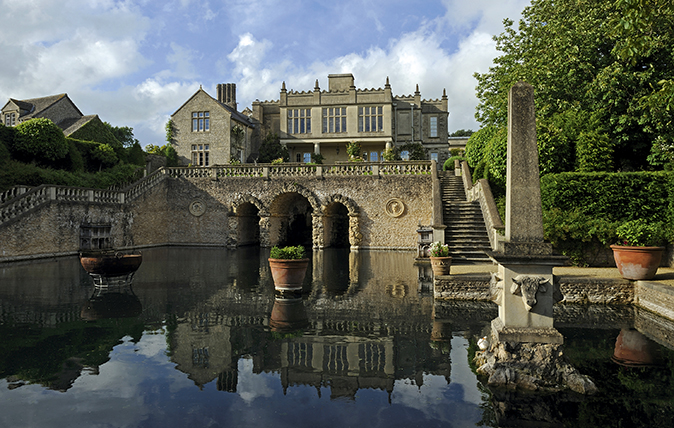
Credit: ©Val Corbett/Country Life Picture Library
Euridge Manor Farm, Wiltshire: A fairytale sense of fun, with a pool where rose petals gather
Non Morris is enchanted by the garden buildings, attention to detail and abundant planting in a recently made Wiltshire garden.

Humphry Repton's 'secret country gem' at Endsleigh, one of the finest hotel gardens in Britain
Non Morris explores the historic 100-acre grounds of Endsleigh, Olga Polizzi’s alluring West Country hotel, designed by Humphry Repton in
